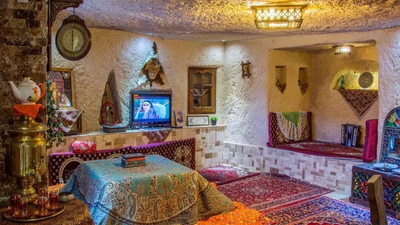
Traditional rural houses showcase unique Middle Eastern architecture.
Rural houses in the Middle East and West Asia are more influenced by the culture and history of the region. These houses are often inspired by local cultural traditions and values and bear symbols of the region's history and cultural identity. In contrast, country houses in Europe and America are usually influenced by modernity and global architectural standards. In rural houses in the Middle East and West Asia, it is common to use local materials such as stone, brick and wood. These materials give the houses a traditional appearance and usually have local symbols. In European and American countries, modern materials such as concrete, metal and glass are used in buildings, and the appearance of the houses is modern and contemporary.
Villages in the Middle East usually enjoy a quiet and simple life. These villages are usually located far from the hustle and bustle of the city and most of their residents are inclined towards nature and simple rural life. This makes Middle Eastern villages popular as places to relax and unwind. The Middle East has very beautiful and diverse natural landscapes. From mountains and high mountains to deserts, valleys, lakes and rivers, this region has a lot of natural diversity. The natural landscapes in the villages of the Middle East are usually considered as popular tourist destinations, and the beauty of nature is a great attraction for domestic and foreign visitors.
Rural houses in the Middle East and West Asia are designed based on the needs of the environment and climate of the region. For example, houses in hot and dry regions are designed using small doors and windows and gardens for shading. On the other hand, in European and American countries, there are more advanced construction technology and heating and cooling systems, and houses are designed to adapt to climate changes. Some factors can reduce the life of rural houses. Factors such as earthquakes, floods, harsh weather, lack of proper maintenance and improper use of the building may cause damage and the need for repair and reconstruction. Country houses can last a very long time if they are properly built and maintained. However, to accurately determine the lifespan of a Middle Eastern country house , one must pay attention to the above and the specific environmental conditions of each region.
The interior design of rural houses in the Middle East and West Asia is also based on local traditions and culture. These houses usually have open spaces and yards, and their use may vary according to the needs of common classifications in other communities. In European and American countries, the interior design of country houses is usually based on comfort and use of spaces for daily life. These houses may have more rooms and larger spaces that are used for various activities such as living room, dining room and bedrooms.
The lifespan of rural houses in the Middle East depends on several factors, including construction materials, quality of construction, type of weather, maintenance, and level of use. In this area, some rural houses have managed to survive the Middle Ages and are still usable, while others need to be renovated and repaired in a shorter period of time. Construction materials used in Middle Eastern rural houses may include stone, wood, brick, clay, and other mineral materials. These materials generally have resistance and long life. For example, stone houses in some rural areas of the Middle East can survive for several centuries.
Unlike some other regions of the world, villages in the Middle East generally have a positive and hospitable attitude towards foreigners. Many villages in the Middle East have long histories of welcoming travelers and guests. People in these villages usually welcome visitors and travelers and try to make them part of their family or community.
Rural homes in Middle East and West Asian countries may have less access to modern technology. In contrast, European and American countries have more advanced infrastructure and homes may include modern smart, security and communication systems. Rural houses in West Asia are mostly designed for the desires and needs of the family and the local community. These houses are used for receiving guests, religious ceremonies and social activities. In European and American countries, country houses are mostly designed for private family life and relaxation.



